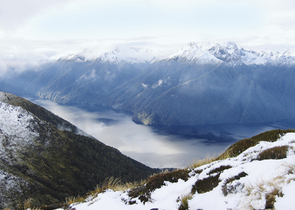Nature Conservation 2/2008 — 22. 4. 2008 — International Nature Conservation
The Fiordland National Park

The Fiordland National Park is located in the southwestern corner of the South Island, one of the two main New Zealand's islands.
It is the largest of the 14 national parks in New Zealand, with an area of 12,500 km2. The large-size protected area is situated in the mountain landscape of the Southern Alps and is highly afforested by primeval, mostly Notophagus forests. Together with the neighbouring Mount Aspiring National Park and with Mount Cook and Westland National Parks, it constitutes the Te Wahipounamu UNESCO World Heritage Site, cove-ring 260,000 km2. Natural beauties, landscape scenery and hundreds of kilometres of marked trails draw huge numbers of visitors there. The Fiordland National Park's wilderness and vast area allow to survive the wild animal species, considered as one of the most threatened taxa worldwide. There only 90 individuals of the flightless parrot, the Kakapo (Strigops habroptilus), left on the planet. The flightless Takahe (Porphyrio hochstetteri) had once inhabited both New Zealand's islands, now numbering approx. 240 individuals only. The Brown Kiwi (Apteryx australis), also known as the Common Kiwi or Tokoeka, has become a New Zealand's national icon: it lives nocturnally in wet primary forests. Intensive recovery programmes for all the above bird species have been implemented by the Department of Conservation, a sectoral governmental body. The most serious threat to both biolo-gical diversity and natural processes in the Fiordland National Park are invasive alien animal species, particularly the Common Brushtail Possum (Trichosurus vulpecula) and Ermine (Mustela erminea), since local ecosystems had been evolved in total isolation for millions of years, without any mammalian predators.
Název připojené galerie
Quisque egestas velit non nulla fermentum, aliquet pharetra nunc malesuada. Nullam molestie vel diam non tincidunt. Sed pulvinar lacinia nunc et consectetur. Duis varius leo ac ex scelerisque, ullamcorper eleifend massa consectetur. Nullam in metus ac arcu pellentesque venenatis ac id lorem. Nulla nec ipsum sed enim sodales blandit a sit amet ex.







